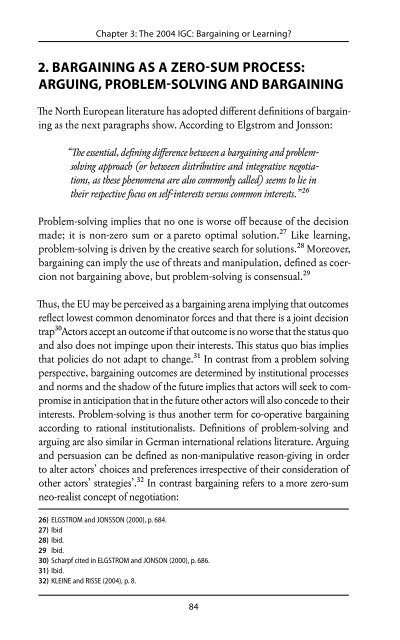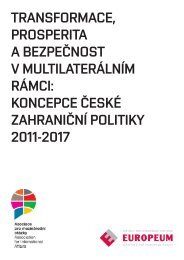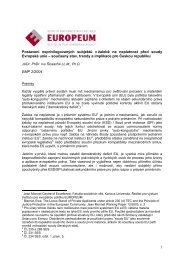eu constitutionalisation - EUROPEUM Institute for European Policy
eu constitutionalisation - EUROPEUM Institute for European Policy
eu constitutionalisation - EUROPEUM Institute for European Policy
Create successful ePaper yourself
Turn your PDF publications into a flip-book with our unique Google optimized e-Paper software.
Chapter 3: The 2004 IGC: Bargaining or Learning?2. BARGAINING AS A ZERO-SUM PROCESS:ARGUING, PROBLEM-SOLVING AND BARGAININGThe North <strong>European</strong> literature has adopted different definitions of bargainingas the next paragraphs show. According to Elgstrom and Jonsson:“The essential, defining difference between a bargaining and problemsolvingapproach (or between distributive and integrative negotiations,as these phenomena are also commonly called) seems to lie intheir respective focus on self-interests versus common interests.”²⁶Problem-solving implies that no one is worse off because of the decisionmade; it is non-zero sum or a pareto optimal solution.²⁷ Like learning,problem-solving is driven by the creative search <strong>for</strong> solutions.²⁸ Moreover,bargaining can imply the use of threats and manipulation, defined as coercionnot bargaining above, but problem-solving is consensual.²⁹Thus, the EU may be perceived as a bargaining arena implying that outcomesreflect lowest common denominator <strong>for</strong>ces and that there is a joint decisiontrap³⁰Actors accept an outcome if that outcome is no worse that the status quoand also does not impinge upon their interests. This status quo bias impliesthat policies do not adapt to change.³¹ In contrast from a problem solvingperspective, bargaining outcomes are determined by institutional processesand norms and the shadow of the future implies that actors will seek to compromisein anticipation that in the future other actors will also concede to theirinterests. Problem-solving is thus another term <strong>for</strong> co-operative bargainingaccording to rational institutionalists. Definitions of problem-solving andarguing are also similar in German international relations literature. Arguingand persuasion can be defined as non-manipulative reason-giving in orderto alter actors’ choices and preferences irrespective of their consideration ofother actors’ strategies’.³² In contrast bargaining refers to a more zero-sumneo-realist concept of negotiation:26) ELGSTROM and JONSSON (2000), p. 684.27) Ibid28) Ibid.29 Ibid.30) Scharpf cited in ELGSTROM and JONSON (2000), p. 686.31) Ibid.32) KLEINE and RISSE (2004), p. 8.Table 1: Arguing and Bargaining as Models of CommunicationMode of Communication/CharacteristicsModalArguingEmpirical and normativeassertions and validity claims(assessment criteria, empiricalproof and consistency andimpartiality); based onargumentative power in thesense of good reasoningBargainingProcedural Relexive SequentialPossible ObservableOutcomeStructuralSource: Ulbert et al, 2004, p. 4.Chapter 3: The 2004 IGC: Bargaining or Learning?Reasoned consensus, actorssubmitting to the betterargument and changinginterests/preferences accordinglyTriadic (speaker and listenerhave to refer to some externalauthority tomake validity claimsPragmatic demands withcredibility claims (assessmentcriteria: credibility ofspeakers); based on bargaingpower in the sense of materialand ideational resources andexit optionsCompromise without changein preferencesDyadic (only mutualassessment counts)Arguing will lead to a consensus identified by the outcome being surprising,beyond the lowest common denominator and explained by actors in thesame way³³ Arguing has been found to be all-pervasive’ during all phases ofinternational negotiation, but it co-exists with bargaining, whereby:“All actors must show their openness to ‘truth –seeking;’ and normativearguments. Hence, even more powerful actors may feel obliged tochange their position in response to smaller actors’ arguing.”³⁴According to this view, the IGC is less likely to involve arguing than theConvention because IGC members are given binding instructions andthere<strong>for</strong>e have fixed preferences, the Convention’s method was by consensusnot by unanimity and the Convention method was more open – theIGC was ‘behind closed doors’.³⁵ Thus, according to this view, the 2004Dublin IGC will exhibit lowest common denominator decision-makingnot consensual learning or non-zero sum processes. In the remainder ofthis paper an overview of the Irish presidency’s management of the 2004is provided and applied to the above hypotheses.33) RISSE, cited in Klein and Risse, (2004), p. 8.34) ULBERT et al. (2004), p. 2.35) KLEINE and RISSE, (2004), p. 10.84 85








